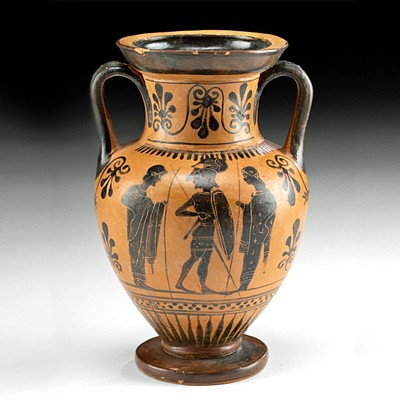Superb Gandharan Schist Statue - Standing Buddha
About Seller
686 S Taylor Ave, Ste 106
Louisville, CO 80027
United States
Selling antiquities, ancient and ethnographic art online since 1993, Artemis Gallery specializes in Classical Antiquities (Egyptian, Greek, Roman, Near Eastern), Asian, Pre-Columbian, African / Tribal / Oceanographic art. Our extensive inventory includes pottery, stone, metal, wood, glass and textil...Read more
Two ways to bid:
- Leave a max absentee bid and the platform will bid on your behalf up to your maximum bid during the live auction.
- Bid live during the auction and your bids will be submitted real-time to the auctioneer.
Bid Increments
| Price | Bid Increment |
|---|---|
| $0 | $25 |
| $300 | $50 |
| $1,000 | $100 |
| $2,000 | $250 |
| $5,000 | $500 |
| $10,000 | $1,000 |
| $20,000 | $2,500 |
| $50,000 | $5,000 |
| $100,000 | $10,000 |
| $200,000 | $20,000 |
About Auction
Mar 9, 2023
Artemis Fine Arts info@artemisgallery.com
- Lot Description
Ancient Central Asia, Afghanistan, India, and Pakistan, Gandharan Empire, ca. 3rd to 4th century CE. A stellar gray schist statue of Buddha standing atop an integral rectangular pedestal surrounded with large, four-petaled flowers. Buddha presents with his left leg slightly extended with a bent knee while wearing a kasaya robe overflowing with finely-sculpted waves and folds. His serene countenance extends above his neck like a beacon - with downcast eyes, arched brows, generous eyelids, an aquiline nose, and full lips - and exudes further radiance via the circular mandorla behind his head. A circular top knot rests above his tightly-bound coiffure while below is a petite urna. A stunning example of fine Greco-Buddhist artistry! Size: 10.6" W x 31.1" H (26.9 cm x 79 cm) <br><br>The Gandharan Empire made itself wealthy in part by controlling lucrative trade along the mountain passes between China in the East and the Near East and Mediterranean in the West; a great deal of this wealth went into local patronage of artisans and art. In the first century CE, Buddhism became fashionable amongst Gandharan elites, and the art produced at this time depicting the Buddha includes some of the most striking Buddhist images from the past. Their artistic tradition also reflects the conquest of Alexander the Great and the introduction of styles from all sides, blended into a uniquely Gandharan tradition, which this Buddha exemplifies. Alexander the Great conquered Gandhara in 330 BCE and with the help of the Indo-Greek kings introduced classical traditions that would influence Gandharan art for the following seven centuries. The stylized wavy Mediterranean hair and top knot that derive from the Apollo Belvedere (330 BCE), as well as the sensitive modeling of the tranquil face displayed on this piece, for example, exhibit this classical influence. <br><br><i>Cf. The Metropolitan Museum of Art, accession number 67.154.5<br><br>For further information on Gandharan art, please see Jongeward, D. "Buddhist Art of Gandhara in the Ashmolean Museum." Oxford, Oxford University Press, 2019.</i><br><br>Please note that this piece is a dropship item, meaning that it will be shipping from the consignor's location. All information regarding condition, size, and metal content have been provided by the consignor.<br><br>PLEASE NOTE: Due to recent increases of shipments being seized by Australian & German customs (even for items with pre-UNESCO provenance), we will no longer ship most antiquities and ancient Chinese art to Australia & Germany. For categories of items that are acceptable to ship to Australia or Germany, please contact us directly or work with your local customs brokerage firm.</i><br><br>East Coast collection, New York Gallery, New York City, New York, USA, acquired before 2010; ex-private art professional M.D. collection, Oxfordshire, England, acquired in the early 2000s; ex-private old A.F. collection, Ontario, Canada, formed in the 1970s.<br><br>#177883
Condition
Right forearm missing, else excellent as shown.
- Shipping Info
-
All shipping is handled in-house for your convenience. Your invoice from Artemis Gallery will include shipping calculation instructions. If in doubt, please inquire BEFORE bidding for estimated shipping costs for individual items.
-
- Buyer's Premium



 EUR
EUR CAD
CAD AUD
AUD GBP
GBP MXN
MXN HKD
HKD CNY
CNY MYR
MYR SEK
SEK SGD
SGD CHF
CHF THB
THB

















